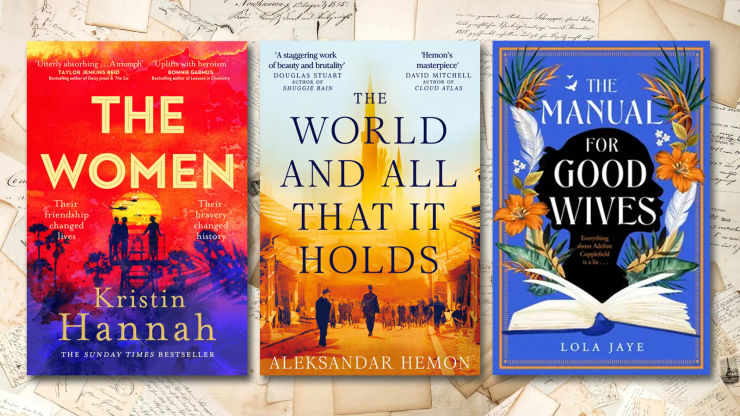12 questions with Kristin Hannah
We sat down with bestselling author Kristin Hannah to discuss inspiration, ambition and writing friendship and family.

A former lawyer-turned writer, Kristin Hannah is an award-winning and bestselling author of more than 20 novels including The Nightingale and Firefly Lane. Here, we sat down to find out a little more about her road to publication and what inspired her latest historical novel, The Four Winds, set in 1930s Dustbowl America.
Can you tell us how you became a published author?
My first career was as a lawyer, but during my first pregnancy I had to have bed rest for five months. It was during that time that I began reading – every book in the house! I remembered a novel that I began writing with my mother before she died. I dusted off the manuscript and began writing. I set myself a deadline of five years to get published.
Friendship and family are at the heart of your books, what draws you to writing about relationships?
I’m drawn to writing about the relationships that form the heart of women’s lives: motherhood, parenthood, friendships. These relationships define who we are and enrich our lives.
Are there any characters in your books that you are most fond of?
An author isn’t supposed to have a favourite character, I have loved writing all of my characters but there are a few that I’m particularly fond of – Izzy from On Mystic Lake, Alice from Magic Hour, and Isabelle from The Nightingale. Isabelle gets to be the hero, and that’s what really drew me to her character.
Your characters are drawn with such depth, do you ever find inspiration from people around you when writing them?
I really strive to create fully developed, multi-dimensional characters that feel true to life, but in reality, fictional characters are never quite as complex, as unpredictable and changeable as real human beings. Often, in the early drafts of a novel, my characters may be inspired in bits and pieces by either people that I know or people from history, the evolution of a story demands that characters change and grow to fit the demands of the narrative.
Your novels often include emotional, heart-wrenching scenes – are these difficult to write?
Sometimes I find the emotional scenes difficult to read back but for the most part the books have been planned out and these scenes are the reason why I have written the book in the first place. I aim to write emotional moments which are true-to-life, without being over the top.
What inspired you to write The Four Winds? The story behind the story of The Four Winds begins a decade ago. Following the publication of my novel, The Nightingale, about the women of the French Resistance, I became aware of how hungry readers were for women’s lost stories. All too often, women’s history has been cast aside or marginalized, forgotten. Like so many readers, I want to understand history in a fuller, more honest way. I want women to be returned to their rightful place in the historical landscape. There are so many remarkable stories of women’s courage and commitment and strength. It’s important that our daughters and granddaughters know about the women who came before them. It’s inspiring.
Five years ago, when I began the search for a new story idea, America was struggling with significant issues of climate change, immigration, and the question of national identity. Who were we as Americans, who did we want to be, who had we become?
I found myself fascinated by the idea of the American Dream and what it means. I couldn’t miss the obvious parallels to another time of great social unrest – the 1930s. It was the similarities between then and now that led me on the path of Great Depression, the Dust Bowl, and the desperate migration of out-of-work people to California.
In the resilience shown by Americans during that terrible time, I found an exceptional story, one that I felt was relevant and important, with clear lessons for today’s world. It is often said that what is past is prologue, and I find that particularly true in this instance. The era of the Dust Bowl and the Great Depression offers profound lessons for the modern world about immigration, man’s negative impact on the land, and the enduring struggle between the haves and the have nots. In writing the novel, I often looked to Dorothea Lange’s work for inspiration. One iconic photograph in particular, “Woman of the High Plains,” provides a stunning portrait of the heartache and grit and desperation of the women of the era. The Four Winds is a tribute to such women and their strength.
I could not have known, of course, that my novel set in the 1930s, about poverty and scarcity, would be published in the first weeks of a pandemic lockdown. It was surreal in those first weeks of publication, to watch the news and see people standing in line for food, for home products, for basic necessities. The Four Winds, in its depiction of hardship, reminds us of something very important right now: that we are tough, that we have survived hard times before, and we are resilient. The world is becoming smaller every day, and I think it’s important to remember the lessons of the past. We need to care for each other, show kindness, and remember that around the world, wherever we are, we are all in this together, and we have the grit and determination to thrive.
Is there a particular place where you like to write?
I have an office but I never use it! I prefer to write in bed, on the sofa – anywhere but at a desk! I have a lovely beach chair outside our home and I’d say that half of my research and writing is done in this chair. I write my stories longhand and then my secretary types this up, I then do the edits.
You’ve written more than twenty novels, how do you decide what to write next?
The worst part of being a writer is coming up with the next idea. An idea has to seize imagination and leave no room for walking away. Writing a novel, from concept to publication, can easily be eighteen months of time, so you are searching for an idea that you want to stick with for that length of time. When I’m looking for a new idea my aim is to write something I haven’t written before.
Which authors have inspired you?
I love to read compelling, beautifully written, emotional stories. Anne Rice and Pat Conroy are amongst the authors who have inspired me.
What is the one book you could read over and over again?
The Lord of the Rings. I first read it when I was thirteen years old, and it has stayed with me for all these years. I love the epic, good vs. evil, ordinary people heroics of it all.
During your writing career, have you ever received rejection or suffered setbacks, and how did you overcome these obstacles?
I think that anyone, in any career, faces setbacks. It’s the human condition. And certainly, if you are reaching for the stars, really trying to do something important or different or unexpected, you are going to encounter difficulties. The point, of course, is not to give up, to keep trying, to keep working and growing and getting better. I spent years working on my first novel and being rejected for it. Each rejection is a teaching tool. Failure can definitely become an opportunity, and that’s how I operated. It’s how I still operate. There is no success without failure, no gain without loss. So, my advice to young writers – young artists of any kind – is don’t let the world get you down and don’t give up. And don’t think that talent is enough. Writing is about hard work and dedication and discipline. I’ve been doing this for three decades, and I still strive to grow and get better with each novel.
Do you have any advice for aspiring authors?
Keep writing, don’t give up! Take classes, make friends with other authors and look at your work critically. Above all else, don’t stop writing!
Discover Kristin's latest book, The Four Winds:
The Four Winds
by Kristin Hannah
Delia Owens, author of Where the Crawdads Sing, called Kristin Hannah's novel ‘powerful and compelling.’ Elsa Martinelli finally has everything she had wished for – a family, a home and a livelihood on a farm on the Great Plains. But when drought threatens her family and community, Elsa must decide whether to stay and fight for the land she loves or flee to California in search of a better life.



